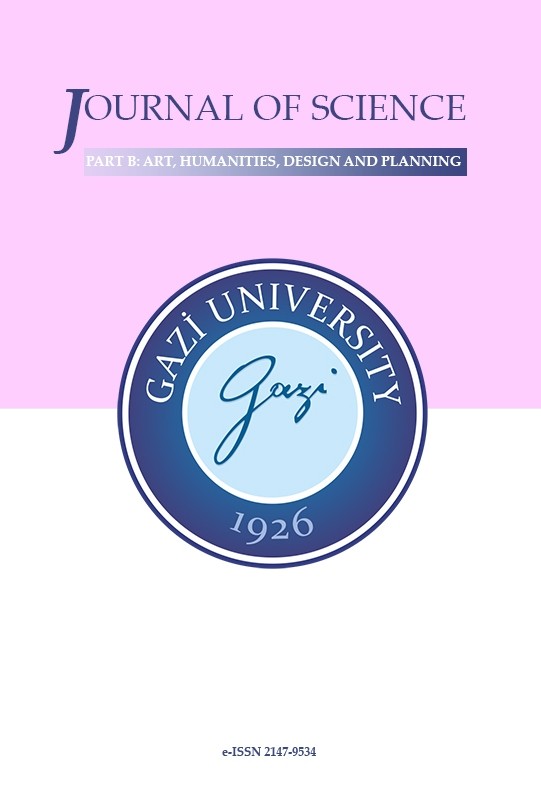Reading the Transformation of Interior Space Perception through Technology
Reading the Transformation of Interior Space Perception through Technology
Perception Space, Technology,
___
- [1] Authors Archive.
- [2] Authors Archive.
- [3] Cüceloğlu, D. (2006). İnsan Ve Davranışı. Remzi Publications
- [4] Varol, E. B. (2004). İnsan-Çevre Etkileşimi Açısından Kamusal Mekanda Sanatın Rolü. Master Thesis. Istanbul Technical University, Institute of Science. İstanbul
- [5] Çelik, M., Aslan, Ş., Koçkan, P. (2013). Teknoloji ve Uygarlık İlişkisinde Mekânların Kimlik Problemi. 2nd National Interior Architecture Symposium. İstanbul: MSGSU Faculty of Architecture, Department of Interior Architecture.
- [6] Özer, B. (2021) Kültür Sanat Mimarlık. YEM Publications. İstanbul. [7] Demir, A. (1981). Çağdaş Teknolojik Gelişmeler. Ankara University Faculty of Political Sciences Publications. No:472
- [8] Hasol, D. (1990). Ansiklopedik Mimarlık Sözlüğü. YEM Publications. İstanbul.
- [9] Ching, F. D. (1996). Architecture: From, Space And Order. United States Of America. Penerbit Willey.
- [10] Usta, G. (2020). Mekan Ve Yer Kavramlarının Anlamsal Açıdan İrdelenmesi. The Turkish Online Journal Of Design Art And Communication, 10(1), 25-30. [11] Kut, S., Aydınlı, S., Erdem, A. (2013). Sibertektonik Mekân. Tasarım+ Kuram Dergisi, 9(15), 21-34. [12] https://www.howarthdesigns.com/inspirations/articles/16_sainte/images/sainte2.jpg [13] http://www.florencia.es/arquitectura-y-arte/los-monumentos/las-iglesias/san-lorenzo [14] Simmel, G. (2019). Modern Kültürde Çatışma. İletişim Publication. İstanbul.
- [15] Mutlu, B. (1996). Mimarlık Tarihi Ders Notları 1, 1st Edition, Mengitan Printing.
- [16] https://www.archdaily.com/397949/ad-classic-the-crystal-palace-joseph-paxton/51d57c57b3fc4b5834000232-ad-classic-the-crystal-palace-joseph-paxton-image?next_project=no
- [17] Mcluhan, M. (2014). Gutenberg Galaksisi Tipografik İnsanın Oluşumu. Yapı Kredi Publications. İstanbul.
- [18] Castells, M. (2021). İnternet Galaksisi. Phoenix Publications. Ankara.
- [19] Virilio, P. (2003). Enformasyon Bombası. Metis Publications. İstanbul.
- [20] Serin, A. P., Akkoy, M. (2020). Bilgi Ve İletişim Teknolojilerindeki Dönüşümün Zaman-Mekânda Sınır Algısına Yansımaları. Tasarım+ Kuram, 16(30), 1-20.
- [21] Gezgin, S., İralı, A. E. (2017). Gelişen Teknoloji Değişen Mekân. Eğitim Publications. İstanbul.
- [22] https://www.arch2o.com/jewel-crown-miguel-chevaliers-complex-meshes-light-durham-cathedral/
- [23] https://www.teamlab.art/w/koi_and_people/
- [24] https://www.teamlab.art/w/waterparticles_bunkanomori/
- [25] https://trendland.com/olfactory-experience-le-grand-musee-du-parfum-paris/
- [26] Baudrillard, J. (2020) Simülakrlar Ve Simülasyon. Doğu Batı Publications. Ankara.
- Yayın Aralığı: Yılda 4 Sayı
- Başlangıç: 2013
- Yayıncı: Gazi Üniversitesi
Historical Evaluation of Public Toilets as Public Spaces
Ergin Kemal KOCAİLİ, Can Mehmet HERSEK
Feshane-i Amire Evaluation of Structural System for Adaptive Reuse
Hilal GÜNAY, Necdet TORUNBALCI, Naz KÖROĞLU
Reading the Transformation of Interior Space Perception through Technology
A Literature-Focused Study: The Furniture Structure Course in Design Education
Hande Zeynep KAYAN, Gamze DEMİRCİ, Didem TUNCEL
Extracting Data-Driven User Segments and Knowledge by Using Online Product Reviews
Restoration Project of Central Cedid Mosque in Erzurum
A Study on The User Satisfaction with The Configuration of Housing Interior Spaces
